翻译理论知识概要1
- 格式:docx
- 大小:15.03 KB
- 文档页数:3
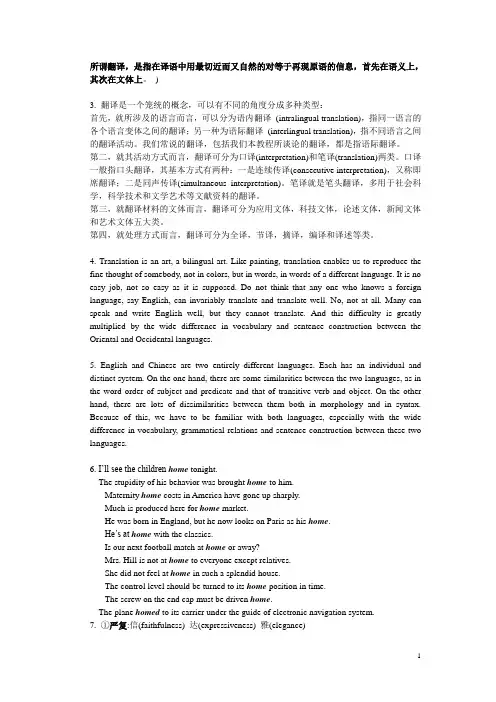
所谓翻译,是指在译语中用最切近而又自然的对等于再现原语的信息,首先在语义上,其次在文体上。
)3. 翻译是一个笼统的概念,可以有不同的角度分成多种类型:首先,就所涉及的语言而言,可以分为语内翻译(intralingual translation),指同一语言的各个语言变体之间的翻译;另一种为语际翻译(interlingual translation),指不同语言之间的翻译活动。
我们常说的翻译,包括我们本教程所谈论的翻译,都是指语际翻译。
第二,就其活动方式而言,翻译可分为口译(interpretation)和笔译(translation)两类。
口译一般指口头翻译,其基本方式有两种:一是连续传译(consecutive interpretation),又称即席翻译;二是同声传译(simultaneous interpretation)。
笔译就是笔头翻译,多用于社会科学,科学技术和文学艺术等文献资料的翻译。
第三,就翻译材料的文体而言,翻译可分为应用文体,科技文体,论述文体,新闻文体和艺术文体五大类。
第四,就处理方式而言,翻译可分为全译,节译,摘译,编译和译述等类。
4. Translation is an art, a bilingual art. Like painting, translation enables us to reproduce the fine thought of somebody, not in colors, but in words, in words of a different language. It is no easy job, not so easy as it is supposed. Do not think that any one who knows a foreign language, say English, can invariably translate and translate well. No, not at all. Many can speak and write English well, but they cannot translate. And this difficulty is greatly multiplied by the wide difference in vocabulary and sentence construction between the Oriental and Occidental languages.5. English and Chinese are two entirely different languages. Each has an individual and distinct system. On the one hand, there are some similarities between the two languages, as in the word order of subject and predicate and that of transitive verb and object. On the other hand, there are lots of dissimilarities between them both in morphology and in syntax. Because of this, we have to be familiar with both languages, especially with the wide difference in vocabulary, grammatical relations and sentence construction between these two languages.6. I’ll see the children home tonight.The stupidity of his behavior was brought home to him.Maternity home costs in America have gone up sharply.Much is produced here for home market.He was born in England, but he now looks on Paris as his home.He’s at home with the classics.Is our next football match at home or away?Mrs. Hill is not at home to everyone except relatives.She did not feel at home in such a splendid house.The control level should be turned to its home position in time.The screw on the end cap must be driven home.The plane homed to its carrier under the guide of electronic navigation system.7. ①严复:信(faithfulness) 达(expressiveness) 雅(elegance)黄龙:信:忠实于原文内容。
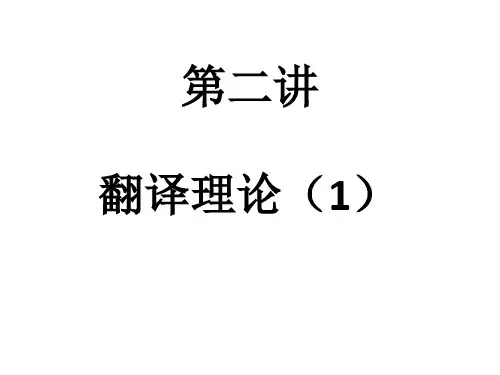
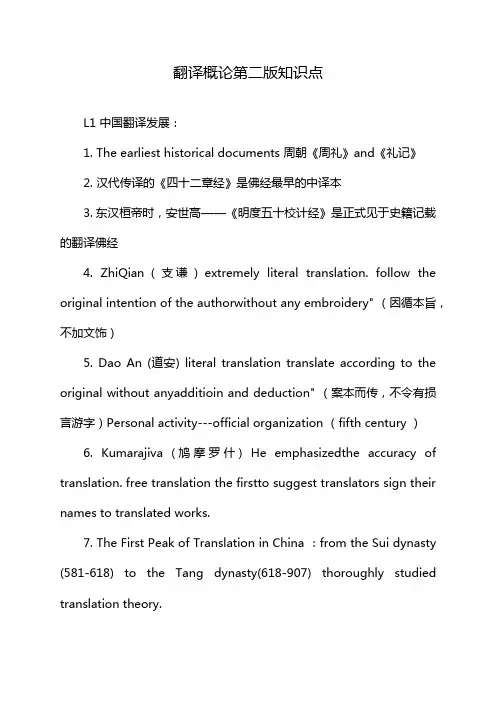
翻译概论第二版知识点L1 中国翻译发展:1. The earliest historical documents 周朝《周礼》and《礼记》2. 汉代传译的《四十二章经》是佛经最早的中译本3. 东汉桓帝时,安世高——《明度五十校计经》是正式见于史籍记载的翻译佛经4. ZhiQian(支谦)extremely literal translation. follow the original intention of the authorwithout any embroidery" (因循本旨,不加文饰)5. Dao An (道安) literal translation translate according to the original without anyadditioin and deduction" (案本而传,不令有损言游字)Personal activity---official organization (fifth century )6. Kumarajiva (鸠摩罗什) He emphasizedthe accuracy of translation. free translation the firstto suggest translators sign their names to translated works.7. The First Peak of Translation in China :from the Sui dynasty (581-618) to the Tang dynasty(618-907) thoroughly studied translation theory.translators should: " (1) be faithful to the Buddhist doctrine, (2) be ready to benefit the readers (Buddhist believers), (3) concentrate on the translation of the Buddhist doctrine rather than translating for fame."8. 玄奘:将佛经由梵文译成汉文,而且把老子著作的一部份译成梵文,成为第一个把汉文著作向国外介紹的中国人Contribution to theory: set down the famous translation criteriathat translation "must be both truthful and intelligible to the populace."( 既須求真,又須喻俗,意即忠实、通順)Aiming to achieve an intelligibility of the translation for the target language readers9. P3. 明清之际的科技翻译Western Christian missionaries (利玛窦...)Assisted by Chinese collaborators ( 徐光启、李之藻)利玛窦、徐光启:《几何原本》、《测量法义》,利玛窦、李之藻《同文算指》,利玛窦:论语、孟子、大学、中庸——拉丁文第二次翻译高潮(1) The subject of translation shifted from Buddhist scriptures to scientific and technologicalknowledge;(2) translators in this period of time were mainly scientists and government officials whowere erudite scholars, and the western missionaries who brought western knowledge to China.10. the 3rd peak :from the mid 19th century to May 4th Movementemphasis on Western works of social soiences, military sciences and literature11. 林则徐(1785-1850):Geography (Gazette of the Four Continents 《四洲志》);李善兰(1811-1882):Geometry《几何原本》;严复:《天演论》、《原富》;林纾:《茶花女》,《块肉余生述》,《黑奴吁天录》《鲁滨逊漂流记》12. Translation in Modern period (1919-1949 ):focus on the translation of Karl Marx's(1818-1883) and Lenin's (1870-19224) works on socialist and communist theories (社会主义和共产主义), and the translation andre-translation of western literature.朱生豪:莎士比亚戏剧全集张谷若:德伯家的苔丝》和《还乡》,哈代的《无名的裘德》、狄更斯的《大卫·考坡菲》P7,鲁迅,矛盾,郭沫若,付东华,傅雷,林语堂13. 杨必:玛丽亚?埃杰窝斯的《剥削世家》,翻译萨克雷(W. M. Thackeray)的Vanity Fair(《名利场》杨宪益和戴乃迭:《红楼梦》《老残游记》《离骚》《儒林外史》《鲁迅选集》《奥德修纪》《卖花女》许渊冲:翻译了《诗经》、《楚辞》、《李白诗选》、《西厢记》、《红与黑》、《包法利夫人》、《追忆似水年华》等众多名著。
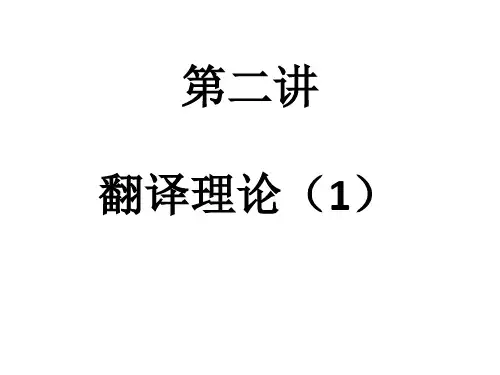
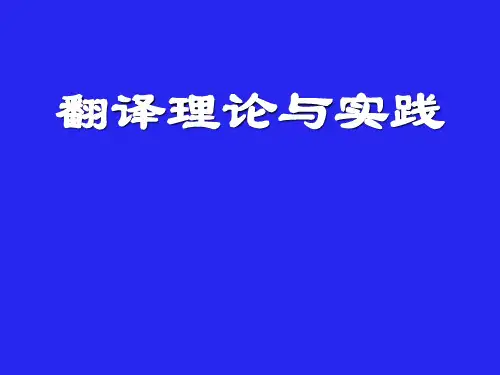
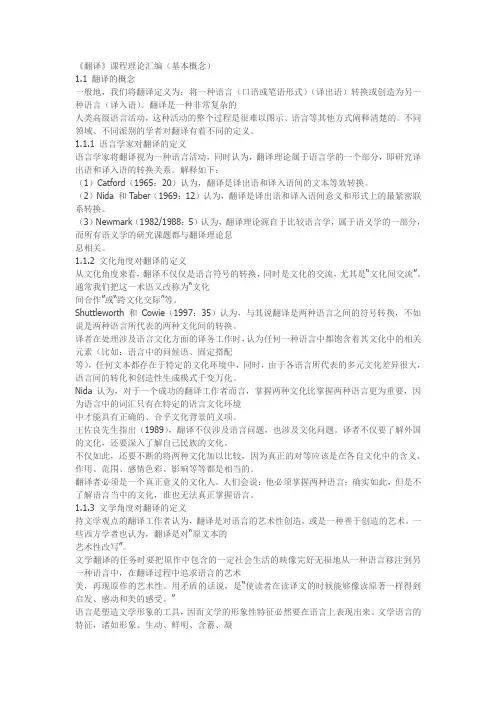
《翻译》课程理论汇编(基本概念)1.1 翻译的概念一般地,我们将翻译定义为:将一种语言(口语或笔语形式)(译出语)转换或创造为另一种语言(译入语)。
翻译是一种非常复杂的人类高级语言活动,这种活动的整个过程是很难以图示、语言等其他方式阐释清楚的。
不同领域、不同派别的学者对翻译有着不同的定义。
1.1.1 语言学家对翻译的定义语言学家将翻译视为一种语言活动,同时认为,翻译理论属于语言学的一个部分,即研究译出语和译入语的转换关系。
解释如下:(1)Catford(1965:20)认为,翻译是译出语和译入语间的文本等效转换。
(2)Nida 和Taber(1969:12)认为,翻译是译出语和译入语间意义和形式上的最紧密联系转换。
(3)Newmark(1982/1988:5)认为,翻译理论源自于比较语言学,属于语义学的一部分,而所有语义学的研究课题都与翻译理论息息相关。
1.1.2 文化角度对翻译的定义从文化角度来看,翻译不仅仅是语言符号的转换,同时是文化的交流,尤其是“文化间交流”。
通常我们把这一术语又改称为“文化间合作”或“跨文化交际”等。
Shuttleworth 和Cowie(1997:35)认为,与其说翻译是两种语言之间的符号转换,不如说是两种语言所代表的两种文化间的转换。
译者在处理涉及语言文化方面的译务工作时,认为任何一种语言中都饱含着其文化中的相关元素(比如:语言中的问候语、固定搭配等),任何文本都存在于特定的文化环境中,同时,由于各语言所代表的多元文化差异很大,语言间的转化和创造性生成模式千变万化。
Nida 认为,对于一个成功的翻译工作者而言,掌握两种文化比掌握两种语言更为重要,因为语言中的词汇只有在特定的语言文化环境中才能具有正确的、合乎文化背景的义项。
王佐良先生指出(1989),翻译不仅涉及语言问题,也涉及文化问题。
译者不仅要了解外国的文化,还要深入了解自己民族的文化。
不仅如此,还要不断的将两种文化加以比较,因为真正的对等应该是在各自文化中的含义、作用、范围、感情色彩、影响等等都是相当的。
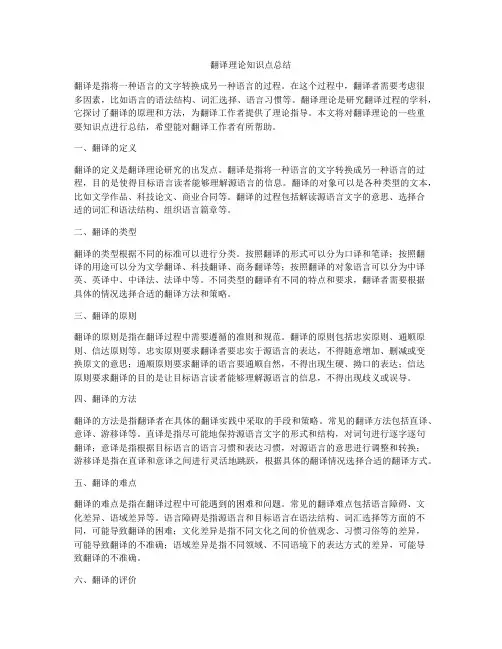
翻译理论知识点总结翻译是指将一种语言的文字转换成另一种语言的过程。
在这个过程中,翻译者需要考虑很多因素,比如语言的语法结构、词汇选择、语言习惯等。
翻译理论是研究翻译过程的学科,它探讨了翻译的原理和方法,为翻译工作者提供了理论指导。
本文将对翻译理论的一些重要知识点进行总结,希望能对翻译工作者有所帮助。
一、翻译的定义翻译的定义是翻译理论研究的出发点。
翻译是指将一种语言的文字转换成另一种语言的过程,目的是使得目标语言读者能够理解源语言的信息。
翻译的对象可以是各种类型的文本,比如文学作品、科技论文、商业合同等。
翻译的过程包括解读源语言文字的意思、选择合适的词汇和语法结构、组织语言篇章等。
二、翻译的类型翻译的类型根据不同的标准可以进行分类。
按照翻译的形式可以分为口译和笔译;按照翻译的用途可以分为文学翻译、科技翻译、商务翻译等;按照翻译的对象语言可以分为中译英、英译中、中译法、法译中等。
不同类型的翻译有不同的特点和要求,翻译者需要根据具体的情况选择合适的翻译方法和策略。
三、翻译的原则翻译的原则是指在翻译过程中需要遵循的准则和规范。
翻译的原则包括忠实原则、通顺原则、信达原则等。
忠实原则要求翻译者要忠实于源语言的表达,不得随意增加、删减或变换原文的意思;通顺原则要求翻译的语言要通顺自然,不得出现生硬、拗口的表达;信达原则要求翻译的目的是让目标语言读者能够理解源语言的信息,不得出现歧义或误导。
四、翻译的方法翻译的方法是指翻译者在具体的翻译实践中采取的手段和策略。
常见的翻译方法包括直译、意译、游移译等。
直译是指尽可能地保持源语言文字的形式和结构,对词句进行逐字逐句翻译;意译是指根据目标语言的语言习惯和表达习惯,对源语言的意思进行调整和转换;游移译是指在直译和意译之间进行灵活地跳跃,根据具体的翻译情况选择合适的翻译方式。
五、翻译的难点翻译的难点是指在翻译过程中可能遇到的困难和问题。
常见的翻译难点包括语言障碍、文化差异、语域差异等。
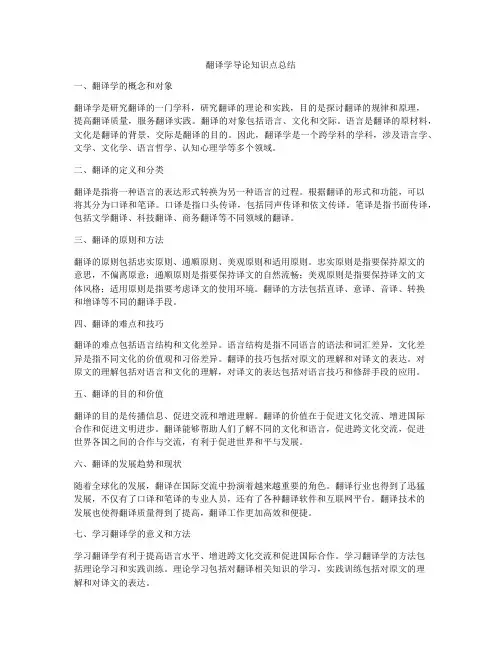
翻译学导论知识点总结一、翻译学的概念和对象翻译学是研究翻译的一门学科,研究翻译的理论和实践,目的是探讨翻译的规律和原理,提高翻译质量,服务翻译实践。
翻译的对象包括语言、文化和交际。
语言是翻译的原材料,文化是翻译的背景,交际是翻译的目的。
因此,翻译学是一个跨学科的学科,涉及语言学、文学、文化学、语言哲学、认知心理学等多个领域。
二、翻译的定义和分类翻译是指将一种语言的表达形式转换为另一种语言的过程。
根据翻译的形式和功能,可以将其分为口译和笔译。
口译是指口头传译,包括同声传译和依文传译。
笔译是指书面传译,包括文学翻译、科技翻译、商务翻译等不同领域的翻译。
三、翻译的原则和方法翻译的原则包括忠实原则、通顺原则、美观原则和适用原则。
忠实原则是指要保持原文的意思,不偏离原意;通顺原则是指要保持译文的自然流畅;美观原则是指要保持译文的文体风格;适用原则是指要考虑译文的使用环境。
翻译的方法包括直译、意译、音译、转换和增译等不同的翻译手段。
四、翻译的难点和技巧翻译的难点包括语言结构和文化差异。
语言结构是指不同语言的语法和词汇差异,文化差异是指不同文化的价值观和习俗差异。
翻译的技巧包括对原文的理解和对译文的表达。
对原文的理解包括对语言和文化的理解,对译文的表达包括对语言技巧和修辞手段的应用。
五、翻译的目的和价值翻译的目的是传播信息、促进交流和增进理解。
翻译的价值在于促进文化交流、增进国际合作和促进文明进步。
翻译能够帮助人们了解不同的文化和语言,促进跨文化交流,促进世界各国之间的合作与交流,有利于促进世界和平与发展。
六、翻译的发展趋势和现状随着全球化的发展,翻译在国际交流中扮演着越来越重要的角色。
翻译行业也得到了迅猛发展,不仅有了口译和笔译的专业人员,还有了各种翻译软件和互联网平台。
翻译技术的发展也使得翻译质量得到了提高,翻译工作更加高效和便捷。
七、学习翻译学的意义和方法学习翻译学有利于提高语言水平、增进跨文化交流和促进国际合作。
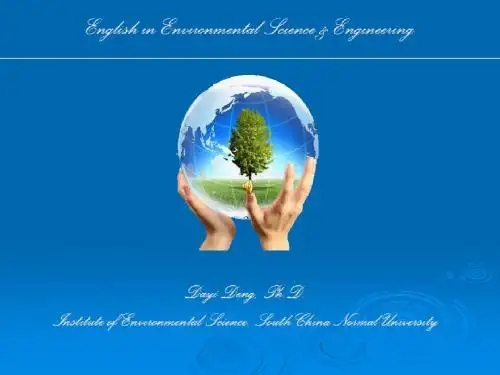
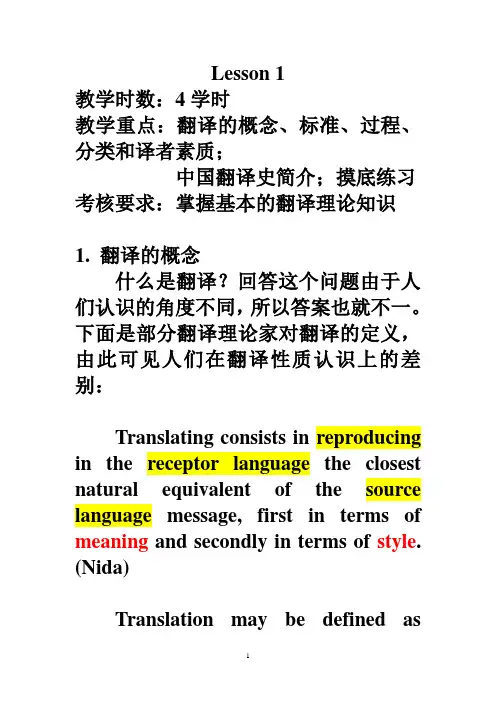
Lesson 1教学时数:4学时教学重点:翻译的概念、标准、过程、分类和译者素质;中国翻译史简介;摸底练习考核要求:掌握基本的翻译理论知识1. 翻译的概念什么是翻译?回答这个问题由于人们认识的角度不同,所以答案也就不一。
下面是部分翻译理论家对翻译的定义,由此可见人们在翻译性质认识上的差别:Translating consists in reproducing in the receptor language the closest natural equivalent of the source language message, first in terms of meaning and secondly in terms of style. (Nida)Translation may be defined asfollows: The replacement of textural material in one language (SL) by equivalent textual material in another language.(TL). (Catford)Translation is a process in which the parole of one language is transferred into the parole of another with the content i.e. meaning unchanged. (Barhudarov)翻译是一种创造性的工作,好的翻译等于创作,甚至还可能超过创作。
(郭沫若)翻译是把一种语言表达的意义用另一种语言传达出来,以达到沟通思想感情、传播文化知、促进社会文明,特别是推动译语文化兴旺昌盛的目的。
(孙致礼)2.翻译的类别翻译的种类可从不同的视角来分类。
一般说来,翻译可从5种不同的角度来分类:1)从译出语和译入语的角度来分类,翻译可分为本族语译为外语外语译为本族语;2)从涉及到的语言符号来分类,翻译分为语内翻译(intralingualtranslation)、语际翻译(interlingual translation)和符际翻译(intersemiotic translation);3) 从翻译的手段来分类,翻译可分为口译(oral interlingual translation)、笔译(written interlingual translation) 和机器翻译(machine translation);4) 从翻译的题材来分类,翻译可分为专业文献翻译(translation of Englishfor science and technology)、文学翻译(literary translation)和一般性翻译(practical writing translation);5)从翻译的处理方式来分类,翻译可分为全译(full translation)、摘译(partial translation)和编译(translation plus editing)。
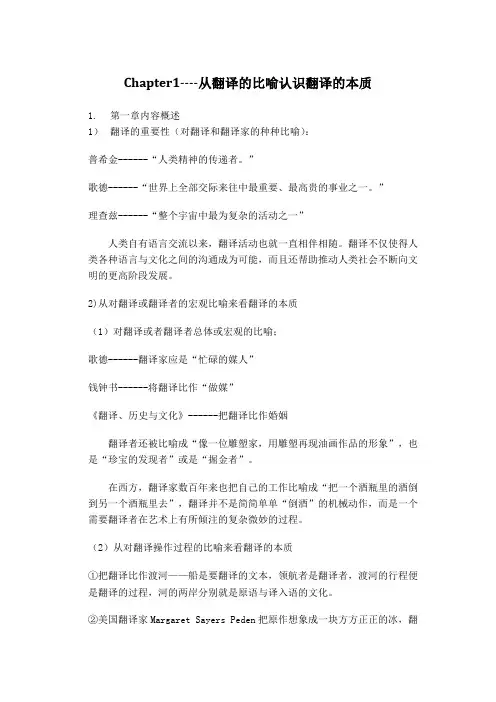
Chapter1----从翻译的比喻认识翻译的本质1.第一章内容概述1)翻译的重要性(对翻译和翻译家的种种比喻):普希金------“人类精神的传递者。
”歌德------“世界上全部交际来往中最重要、最高贵的事业之一。
”理查兹------“整个宇宙中最为复杂的活动之一”人类自有语言交流以来,翻译活动也就一直相伴相随。
翻译不仅使得人类各种语言与文化之间的沟通成为可能,而且还帮助推动人类社会不断向文明的更高阶段发展。
2)从对翻译或翻译者的宏观比喻来看翻译的本质(1)对翻译或者翻译者总体或宏观的比喻;歌德------翻译家应是“忙碌的媒人”钱钟书------将翻译比作“做媒”《翻译、历史与文化》------把翻译比作婚姻翻译者还被比喻成“像一位雕塑家,用雕塑再现油画作品的形象”,也是“珍宝的发现者”或是“掘金者”。
在西方,翻译家数百年来也把自己的工作比喻成“把一个酒瓶里的酒倒到另一个酒瓶里去”,翻译并不是简简单单“倒酒”的机械动作,而是一个需要翻译者在艺术上有所倾注的复杂微妙的过程。
(2)从对翻译操作过程的比喻来看翻译的本质①把翻译比作渡河——船是要翻译的文本,领航者是翻译者,渡河的行程便是翻译的过程,河的两岸分别就是原语与译入语的文化。
②美国翻译家Margaret Sayers Peden把原作想象成一块方方正正的冰,翻译的过程就是这块冰的熔化过程。
这个比喻借用了自然科学对物质从一种状态变成另一种状态的描述,十分生动,也颇富揭示性。
③对翻译,另一种最新的、更具揭示性的比喻是“没有舞台的演出”。
④巴西翻译家——“食人者”对翻译者或者翻译的种种比喻尽管五花八门,但都有一个明显的特征,即它们基本上都是正面的,都包含对翻译者工作的褒扬,是确实还有少数比喻表达了对翻译或翻译者的否定或批评;如“翻译即背叛者等”。
2)翻译的本质翻译是一种文化传播的工具,在国与国之间、原语文化与译入语文化之间起着桥梁和纽带的作用;翻译不仅仅是文本从一种语言向另一种语言的过渡,也是文本之间、文化之间的一种协商过程,是以翻译者为中间人进行交流和斡旋的过程;翻译不仅仅是一门涉及语符转换、意义传递的技巧或技艺,更是一项极富创造性、挑战性的活动,是“一种艺术,一种需要译者像画家、表演家”那样具有高超创作才能的艺术。
翻译理论总结期末在现代全球化的背景下,翻译作为一种重要的跨文化交流方式,发挥着不可或缺的作用。
翻译理论作为研究翻译实践的基础,是翻译工作者必须掌握的重要知识。
本文将综述翻译理论的重要概念、发展历程和主要流派,从而对翻译实践提供指导和启示。
一、翻译理论的重要概念1. 翻译翻译是指将一种语言的信息转化为另一种语言的过程。
它不仅仅是语言的互译,还涉及到思维方式、文化背景等因素。
2. 等效等效是指在翻译过程中,力求使目标语言能够传达出原文同样的意义和效果。
等效主张在翻译理论中占据重要地位,它涉及到文化差异、语言差异等问题。
3. 重译重译是指对一篇已经翻译过的文本重新进行翻译。
它是翻译实践中的一种特殊形式,可以通过不同解读和译者的风格差异来实现更好的翻译效果。
4. 归化与异化归化与异化是翻译理论中常用的两个概念,它们分别指代将目标语文化与源语文化“融合”或“保留”的翻译策略。
归化主张将目标语文化中的表述方式与理解习惯作为翻译的依据,而异化则更加强调源语文化的独特性。
二、翻译理论的发展历程1. 传统翻译理论传统翻译理论以源语为中心,更加注重语言的形式对称性,重视忠实于原文,以达到“无损”的目标。
2. 功能对等理论功能对等理论是在20世纪70年代后期兴起的,提出了等效的概念,并关注功能与意义在翻译中的重要性。
该理论明确了译者在翻译过程中应对源语和目标语读者进行调整的任务。
3. 文化转移理论文化转移理论提出了文化因素在翻译中的重要作用。
它强调翻译不仅仅是语言的转移,还涉及到文化背景、思维方式等因素。
这一理论对于跨文化交流的研究具有重要指导意义。
4. 重译和再翻译理论重译和再翻译理论强调翻译是一个不断发展的过程,通过对已有翻译作品的再审视和重新翻译,可以实现更好的翻译效果。
这一理论提醒翻译者不仅要注重翻译策略,还要不断提升自己的翻译水平。
三、翻译理论的主要流派1. 源语导向理论源语导向理论以源语为中心,强调翻译要忠实于原文,力求实现“无损”翻译。
翻译概论Chapter1-2从翻译的比喻认识翻译的本质及翻译的原则Chapter1----从翻译的比喻认识翻译的本质1.第一章内容概述1)翻译的重要性(对翻译和翻译家的种种比喻):普希金------“人类精神的传递者。
”歌德------“世界上全部交际来往中最重要、最高贵的事业之一。
”理查兹------“整个宇宙中最为复杂的活动之一”人类自有语言交流以来,翻译活动也就一直相伴相随。
翻译不仅使得人类各种语言与文化之间的沟通成为可能,而且还帮助推动人类社会不断向文明的更高阶段发展。
2)从对翻译或翻译者的宏观比喻来看翻译的本质(1)对翻译或者翻译者总体或宏观的比喻;歌德------翻译家应是“忙碌的媒人”钱钟书------将翻译比作“做媒”《翻译、历史与文化》------把翻译比作婚姻翻译者还被比喻成“像一位雕塑家,用雕塑再现油画作品的形象”,也是“珍宝的发现者”或是“掘金者”。
在西方,翻译家数百年来也把自己的工作比喻成“把一个酒瓶里的酒倒到另一个酒瓶里去”,翻译并不是简简单单“倒酒”的机械动作,而是一个需要翻译者在艺术上有所倾注的复杂微妙的过程。
(2)从对翻译操作过程的比喻来看翻译的本质①把翻译比作渡河——船是要翻译的文本,领航者是翻译者,渡河的行程便是翻译的过程,河的两岸分别就是原语与译入语的文化。
②美国翻译家Margaret Sayers Peden把原作想象成一块方方正正的冰,翻译的过程就是这块冰的熔化过程。
这个比喻借用了自然科学对物质从一种状态变成另一种状态的描述,十分生动,也颇富揭示性。
③对翻译,另一种最新的、更具揭示性的比喻是“没有舞台的演④巴西翻译家——“食人者”对翻译者或者翻译的种种比喻尽管五花八门,但都有一个明显的特征,即它们基本上都是正面的,都包含对翻译者工作的褒扬,是确实还有少数比喻表达了对翻译或翻译者的否定或批评;如“翻译即背叛者等”。
2)翻译的本质翻译是一种文化传播的工具,在国与国之间、原语文化与译入语文化之间起着桥梁和纽带的作用;翻译不仅仅是文本从一种语言向另一种语言的过渡,也是文本之间、文化之间的一种协商过程,是以翻译者为中间人进行交流和斡旋的过程;翻译不仅仅是一门涉及语符转换、意义传递的技巧或技艺,更是一项极富创造性、挑战性的活动,是“一种艺术,一种需要译者像画家、表演家”那样具有高超创作才能的艺术。
第一章翻译的基本概念与知识Part l.翻译溯源1.1唐时期的佛经翻译早在西汉哀帝时期,有个叫伊存的人到中国来口传一些简短的佛教经句但不是真正意义的佛经翻译。
西汉武帝时期张骞出使西域,接触了佛经,从此,拉开了佛经翻译的序幕。
佛经的翻译正式始于东汉桓帝建和二年。
波斯人安世高翻译了《安般守意经》等三十多部经书;竺法护翻译了175部经书,对佛教的流传作出了巨大的贡献。
此外,安清、支亮、支谦等在当时也很有必要名气。
东晋到隋时期的翻译事业有了进一步的发展。
道安主持译场,严格主张直译,还请来印度人鸠摩罗什Kumarajiva。
鸠摩罗什一改古直风格,主张意译,译著有《金刚经》、《法华经》等三百余卷,为我国的翻译文学奠定了基础。
南北朝时期的印度学者真谛Paramartha翻译了《摄大乘论》等49部经论,对中国的佛教思想有较大的影响。
唐朝,是我国佛经翻译的鼎盛时期,翻译大家玄奘在唐太宗贞观二年去印度取经,历时间17年,带回佛经657部,《西游记》A Pilgrimage to the West便是以他的取经经历为蓝本的。
在19年里,共翻译山75部佛经,多达1335卷,1300多万字。
他不仅把佛经翻译成汉语,而且是将老子著作翻译成梵文,他是将汉语著作介绍给外国人的中国第一人。
1.2明清时期翻译明未有许多有志之士认识到西方科学的先进,立志引进西学,其中,徐光启贡献最大。
他与意大利传教士利马竇,M. Ricci合译了欧几里得《几何学》。
清朝在各地专设翻译出版机构,西方流行的政治学说与文化艺术大规模地传进中国。
贡献较人的有晚清的严复,他在13年期间翻译了一些西方政治经济学说,如赫胥黎(T.H.Huxley)著的《天演论》Evolution and Ethics and Other Essays、亚当·斯密(A. Smith)著的《原富》An Inquiry Into the Nature and Cause of the Wealth of Nations、约翰·穆勒(J.s.Mill)著的《群己权界论》On Liberty 及甄克思E. Jenks著的A History of Politics《社会通诠》等。
翻译理论知识《翻译理论与实践》考试理论部分复习提纲一、翻译定义:1. 张培基——翻译是用一种语言把另一种语言所表达的思维内容准确而完整地重新表达出来的语言活动。
3. 刘宓庆——翻译的实质是语际的意义转换。
4. 王克非——翻译是将一种语言文字所蕴含的意思用另一种语言文字表达出来的文化活动。
5. 泰特勒——好的翻译应该是把原作的长处完全地移注到另一种语言,以使译入语所属国家的本地人能明白地领悟、强烈地感受,如同使用原作语言的人所领悟、所感受的一样。
6. 费道罗夫——翻译就是用一种语言把另一种语言在内容与形式不可分割的统一中所业已表达出来的东西准确而完全地表达出来。
7. 卡特福德-- 翻译的定义也可以这样说:把一种语言(Source Language)中的篇章材料用另一种语言(Target Language)中的篇章材料来加以代替。
8. 奈达——翻译就是在译入语中再现与原语信息最切近的自然对等物,首先就意义而言,其次就是文体而言。
“ Translating consists in reproducing in the receptor language the closest natural equivalent of the source language message, first in terms of meaning and secondly in terms of style.” ---Eugene Nida纽马克——通常(虽然不能说总是如此),翻译就是把一个文本的意义按作者所想的方式移译入另一种文字(语言)。
“ Translation is a craft consisting in the attempt to replace a written message and/or statement in one language by the same message and/or statement in another language”. --- Peter Newmark10. “ Translation is the expression in one language (ortarget language 译入语) of what has been expressed in another language (source language 原语), preserving semantic and stylistic equivalences.” --- Dubois12. 13.Translation or translating is a communicative activity or dynamic process in which the translator makes great effort to thoroughly comprehend a written message or text in the source language and works very hard to achieve an adequate or an almost identical reproduction in the target language version of the written source language message or text.二、翻译标准1. 翻译的标准概括为言简意赅的四个字:“忠实(faithfulness)、通顺(smoothnesS”忠实指的是忠实于原文。
翻译基本理论知识点
中文翻译的基本理论知识点如下:
1.句子结构分析:理解句子的结构是翻译的基础,包括主谓宾结构、修饰语等,翻译时需要保持句子结构的完整性。
2.语义理解:翻译时需要深入理解每个词语的含义,并了解词语之间的语义关系,以准确传达原文的意思。
3.上下文理解:翻译时需要考虑上下文的信息,以确保所翻译的内容与原文的语境一致。
4.语法转换:中文和其他语言的语法结构有所不同,需要进行语法转换以符合目标语言的语法规则。
5.文化差异:不同语言和文化背景下,同样的表达方式可能含有不同的意义,需要考虑并妥善处理文化差异。
6.辞职翻译:辞职翻译是指逐句对照原文进行翻译,保持原文的字面意思,适用于宗教经典、技术说明等需要精确传达内容的场景。
翻译理论知识概要第一部分:翻译术语1. Definitions of translationTranslation can be roughly defined as a reproduction or recreation in one language of what is written or said in another language.Being a very complicated human activity, its whole picture is never easy to describe.Scholars with different academic backgrounds have attempted to define it from various perspectives.(1). Linguistic Views on TranslationTranslation theorists from the linguistic school conceive of translation as a linguistic activity and some believe that translation theory is a branch of linguistics, approaching the issues of translating primarily from the viewpoint of the linguistic differences between source and target texts.Translation may be defined as the replacement of textual material in one language (the source language)by equivalent textual material in another language (the target language). (Catford,1965: 20).Translating consists in reproducing in the receptor language the closest natural equivalent of the source-language message, first in terms of meaning and secondly in terms of style. (Nida & Taber,1969:12).Translation theory derives from comparative linguistics, and within linguistics, it is mainly an aspect of semantics;all questions of semantics relate to translation theory.(Newmark,1982/1988:5).(2). Cultural Views on TranslationIn the cultural approach,translation is regarded not only as a transfer of linguistic signs, but also as a communication of cultures,i.e.translation is an "intercultural communication"; hence the terms of "intercultural cooperation", "acculturation", and "transculturation".Translation is a process which occurs between cultures rather than simply between languages {Shuttleworth & Cowie,1997:35).A translator who uses a cultural approach is simply recognizing that each language contains elements which are derived from its culture (such as greetings, fixed expressions and REALIA), that every text is anchored in a specific culture, and that conventions of text production and reception vary from culture to culture (Shuttleworth & Cowie1997:35).For truly successful translating, biculturalism is even more important than bilingualism, since words only have meanings in terms of the cultures in which they function. (Nida, 2001:82).翻译不仅涉及语言问题,也涉及文化问题。
译者不仅要了解外国的文化, 还要深入了解自己民族的文化。
不仅如此, 还要不断地把两种文化加以比较, 因为真正的对等应该是在各自文化中的含义、作用、范围、感情色彩、影响等等都是相当的。
翻译者必须是一个真正意义的文化人。
人们会说:他必须掌握两种语言; 确实如此, 但是不了解语言当中的社会文化, 谁也无法真正掌握语言(王佐良,1989)。
(3).Literary Views on TranslationTranslators who hold this view believe that translation is an artistic recreation or a recreated art. Some modern Western scholars from the literary school take literary translation to be "the manipulation or rewriting of the source texts".文学翻译的任务是要把原作中包含的一定社会生活的映象完好无损地从一种语言移注到另一种语言中, 在翻译过程中追求语言的艺术美, 再现原作的艺术性。
用茅盾的话说, 是"使读者在读译文的时候能够像读原作时一样得到启发、感动和美的感受"。
语言是塑造文学形象的工具, 因而文学的形象性特征必然要在语言上表现出来。
文学语言的特征, 诸如形象、生动、鲜明、含蓄、凝练、准确、风趣、幽默、辛辣、滑稽、悦耳、民族特点、地方色彩, 还有行业习语、民间的俚语、谚语等等, 都是作家根据塑造形象的需要, 从现实生活中提炼创造出来的。
文学作品的艺术形式与思想内容是辩证统一的, 翻译要保存原作风格特点, 因此要求译文生动形象、形神毕肖、雅俗等同、简洁精美、词情并茂(《译学辞典》2004: 291)。
(4). Semantic Views on TranslationThis view focuses on the semantic equivalence between the two languages,as well expressed by Eugene Nida(1986):"Translating means translating meaning".Translation is rendering the meaning of a text into another language in the way that the author intended the text (Newmark,1988:5).Semantic translation: the translator attempts,within the bare syntactic and semantic constraints of the target language,to reproduce the precise contextual meaning of the author (Newmark,1982:22).In semantic translation, greater attention is paid to rendering the author's original thought-processes in target language than to attempting to re-interpret source text in a way which the translator considers more appropriate for the target setting (Shuttleworth & Cowie,1997:151).(5).Functional Views on TranslationFunctionalists believe that translation is a specific form of human action with a certain purpose, a kind of linguistic service provided to the society.Translators should take into account the needs of the client, the reader as wellas the purpose or use of the translation:It is not the source text, or its effects on the source-text recipient, or the function assigned to it by the author, that determines the translation process, but the prospective function or purpose of the target text as determined by the initiator's,i.e.client's needs (Baker,2001:236).(6).Communicative Views on TranslationThis approach views translation as a communicative process which takes place within a social context.Communicative translation:the translator attempts to produce the same effect on the target language readers as was produced by the original on the source language readers (Newmark, 1982:22).Communicative translation is generally oriented towards the needs of the target language reader or recipient. A translator who is translating communicatively will treat source text as a message rather than a mere string of linguistic units,and will be concerned to preserve source text's original function and to reproduce its effect on the new audience (Shuttleworth & Cowie,1997:21).The above views help us to understand the complex nature of translation. Since there are many factors which affect the translation process, translation is a complicated human activity.。